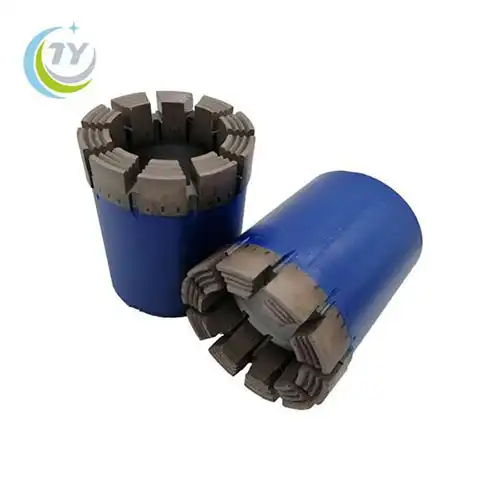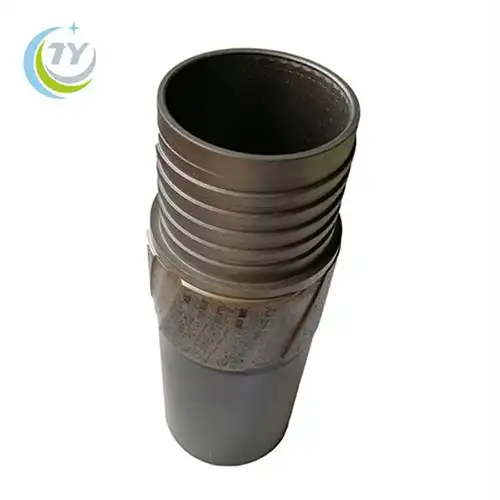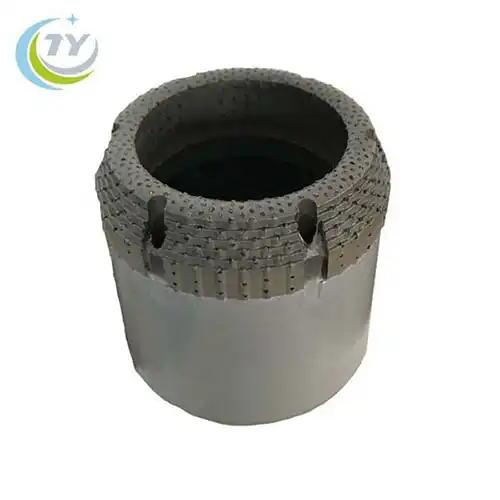What is Diamond Core Bit?
Diamond core bits are drill bits that are welded with tiny particles of diamond, the toughest material known. As such these drill bits can cut through the hardest of tiles, including porcelain, ceramics, marble, granite and vitrified tiles.
Benefits of Diamond Core Bit
Minimal mess
In comparison to alternative drilling methods, diamond drills cut through hard construction surfaces without leaving dust and debris all over the place. This saves making a mess and wasting precious time.
Maintain structural Integrity
The idea of drilling into buildings creates fears of damaging structural integrity. However, diamond core drilling is one of the safest drilling forms, ensuring that structural integrity remains intact.
Precision
You are most likely to get the perfect results you desire with a diamond drill, as it is one of the most precise methods of cutting, leaving every project with an accurate finish.
The depth of cutting can also be extremely varied – ranging from 10 to 1000 millimetres. If precise holes are required, a diamond core drill can be used to create duct openings, pipes, wiring holes, and holes for fasteners.
Versatility
Looking for a tool that is both accurate and versatile? Well, look no further! Diamond drills can be used on many different construction surfaces.
Due to their portability and compact design, you are not limited in the locations and materials you can use to cut. The drill bits are also extremely resistant to damage, making them a perfect long-term investment.
Lightweight
Diamond core drills have a lightweight and compact design that doesn’t affect their immense power and seamless performance. This makes them super easy to transport.
You can use the diamond core drilling method virtually anywhere, including in the contexts of both dry and wet drilling.
Why Choose Us
High-quality standards Our products are made to high-quality standards, ensuring that they are durable and long-lasting. We use only the best materials and the latest manufacturing techniques to create our products. | Competitive prices We offer our flange products at competitive prices, ensuring that our customers get the best possible value for their money. |
Expertise We have a team of experts who have many years of experience in the flange industry. | Customer service We pride ourselves on providing excellent customer service and ensuring that our customers are satisfied with their purchases. We are always available to answer any questions or concerns that our customers may have. |
Material Of Diamond Core Bit
Carbon tool steels
Carbon tool steels are used for applications where little heat is going to be generated. Both low and high carbon steels are both used for diamond core bit bits, but for different purposes. Soft low carbon steel cannot cut hard metals due to their poor tempers, but it can cut softwoods and plastics. They require sharpening to extend their lifespan. The primary bonus of low carbon steel is its relative inexpensiveness, especially when compared to some more exotic drill bit materials.
High carbon steels have better tempers than low carbon steels, so they require less maintenance, such as sharpening, and hold their form and effectiveness longer. They can cut both woods and metals, and if available, are preferred to low carbon steels when cutting extremely hard woods.
High-speed steel
High-Speed Steel (HSS) is a preferred material for use in diamond core bit bits since it has a higher red hardness and improved wear resistance. These properties allow for drilling at higher operating speeds and into harder materials. The friction created by high-speed turning can raise temperatures dramatically, but HSS is designed to operate at these higher speeds. HSS can function at normal temperatures, as well, but only at a level equal to standard carbon steel. HSS can also take coatings, such as titanium nitride, which give the drill bit better lubricity, decreasing friction and helping to extend the bit's life.
Cobalt high-speed steel
Cobalt High-Speed Steel (HSS) drill bits have added Cobalt which gives the material a higher red hardness than standard HSS. This additional hardness permits these drill bits to be used for drilling materials that have a hardness of Rockwell 38C or greater such as treated stainless steel, cast iron, or titanium. They are also capable of being utilized at higher cutting speeds than conventional HSS and exhibit superior abrasion resistance.
Tungsten carbide
Tungsten carbide is an extremely hard and wear-resistant material. Drill bits with tungsten carbide tips are effective for drilling into hard materials such as concrete, masonry, and some metals. Solid carbide drill bits are suitable for high-speed drilling applications.
Carbide tipped
Carbide-tipped drill bits combine the toughness of steel with the hardness of tungsten carbide inserts. These bits are effective for drilling into hard materials and are commonly used in masonry and woodworking.
Diamond-coated
Diamond-coated drill bits are designed for drilling into extremely hard materials like glass, ceramics, and tiles. The diamond coating provides excellent hardness and wear resistance.
Black oxide-coated
Black oxide-coated drill bits have a coating that enhances their durability and provides some corrosion resistance. They are suitable for general-purpose drilling in various materials.
Titanium-coated
Titanium-coated drill bits have a layer of titanium nitride that increases their hardness and reduces friction. These bits are suitable for drilling into metal, wood, and plastic.
Types Of Diamond Core Bit
Straight-shank drill bits
Straight-shank drill bits have a cylindrically shaped shank that may or may not be the same diameter as that of the drill body.
Taper-shank drill bits
Taper-shank drill bits are ones with a conically shaped shank that permits the drill bit to fit into tapered holes in machine spindles, driving sleeves, or sockets. Taper-shank drill bits will usually have a tang at the end of the shank which will fit into a driving slot in the socket.
Two-flute drill bits
Two-flute drill bits are the typical style of drill bit that is used to create new holes in a workpiece.
Three-flute drill bits and Four-flute drill bits
Three-flute drill bits and Four-flute drill bits are used to enlarge or finish pre-existing holes that have been drilled, cast, or punched in a material, but they are not used to create new holes.
Coating Treatment of Diamond Core Bit
Titanium
Titanium is a corrosion-resistant metal, and in the form of titanium nitride, is used as a coating applied to HSS drill bits to give them very high levels of surface hardness. This characteristic allows titanium-coated drill bits to be used to drill tough materials and last up to 6 times longer than standard HSS bits. This longevity makes it attractive for use in repetitive, large runs. It is a very versatile drill bit coating, and it can cut a broad variety of surfaces, including many types of steel and iron, as well as softer materials including wood, drywall, and plastic. The addition of titanium nitride also reduces friction between the bit and the workpiece, significantly reducing heat and therefore wear.
Black oxide
Black oxide is not a coating but rather a heat treatment process that is applied to HSS which reduces friction and increases the life of the drill bit by some 50% over that of standard HSS. They are created by heating HSS to 950 degrees F to add corrosion and rust resistance. These bits can be used for carbon steels, alloy steels, as well as softer materials such as wood, plastics, PVC, drywall as well as softer metals such as copper and aluminum.
Zirconium coating
While not a primary material for drill diamond core bit, zirconium-coated metals function very well for drill bits. The zirconium nitride coating can increase strength for hard but brittle materials, like steel. The makeup of the zirconium also decreases friction for improved precision drilling.
Diamond
Some diamond core bit are embedded with diamond dust; these are available as either hollow core bits or as smaller blunt nose bits with no open space in the middle. The diamond enables them to cut through materials like glass, gemstones, ceramic, bone, and stone. However, they should not be used on ferrous metals.
How To Use A Diamond Core Bit
Prepare the diamond core bit and job site
Before actually operating the core drill, it is important to prepare the job site and ensure the drill is ready for use. You will want to:
● Check for alignment and possible binding of moving parts, mounting, and any other conditions that may affect core drill operation. Do not use the core drill if it shows any signs of damage.
● Read and fully understand the operating manual.
● Check the power supply's flow and pressure output against the core drill's requirements.
● Check for live electrical wiring near the work site or embedded in the material being drilled.
● If drilling through a wall, check both sides for possible obstructions.
● Before drilling through a floor, provide protection for all personnel and materials below the work area. Cores generally drop from the bit at the completion of the hole.
● Ensure all personnel is using the appropriate safety equipment.
● Clear the working area of all unauthorized personnel. Place barricades or secure the area so that no person can be injured.
Anchoring a core drill
A core drill can typically be bolt anchored or ceiling jack anchored to the floor or bolt anchored to the wall.
● Measure the distance from the center of the anchor bolt slot in the base to the center of the drill spindle.
● Mark from the center of the hole on the floor to be drilled to the spot where the anchor bolt hole will be drilled.
● Drill and set the anchor bolt. Then place core drill over anchor hole and hand tighten the bolt.
● Secure the core drill by tightening the anchor bolt.
Installing a drill bit
Before installing the drill bit, ensure that neither the bit nor the core drill is hot. What's more, always make sure to wear protective gloves when handling, installing, and removing core drill bits.
Next, remove any dirt or contamination that may have accumulated on either the bit or drill spindle. Once you do that, you can begin to thread the drill bit onto the drill spindle and tighten it securely with a bit wrench.
Operating the core drill
Once you have done the steps above, you are ready to operate the core drill. During this process, you will want to do the following:
● Check the hole alignment by lowering the bit with the feed handle until the bit is about 1/2 inch from the concrete. It is important to ensure the bit is not resting on the concrete when starting the core drill.
● Make sure to always check the manufacturer's recommendation for drill speed.
● Keep all body parts away from all moving parts of the core drill while in operation.
Application of Diamond Core Bit
Diamond core bits can be effectively used to create a diverse range of holes. All of which will be cleanly and precisely formed. You can use this to make larger openings. With the help of equipment, it is possible to drill holes ranging between 8 mm to 1500 mm.
Mainly, diamond drilling can be used for drilling through concrete. But, it can also be used to cut through many materials, including reinforced concrete, tiles, glass, and masonry. So, diamond drilling is suitable for a variety of works. You can even use those that are underwater.











